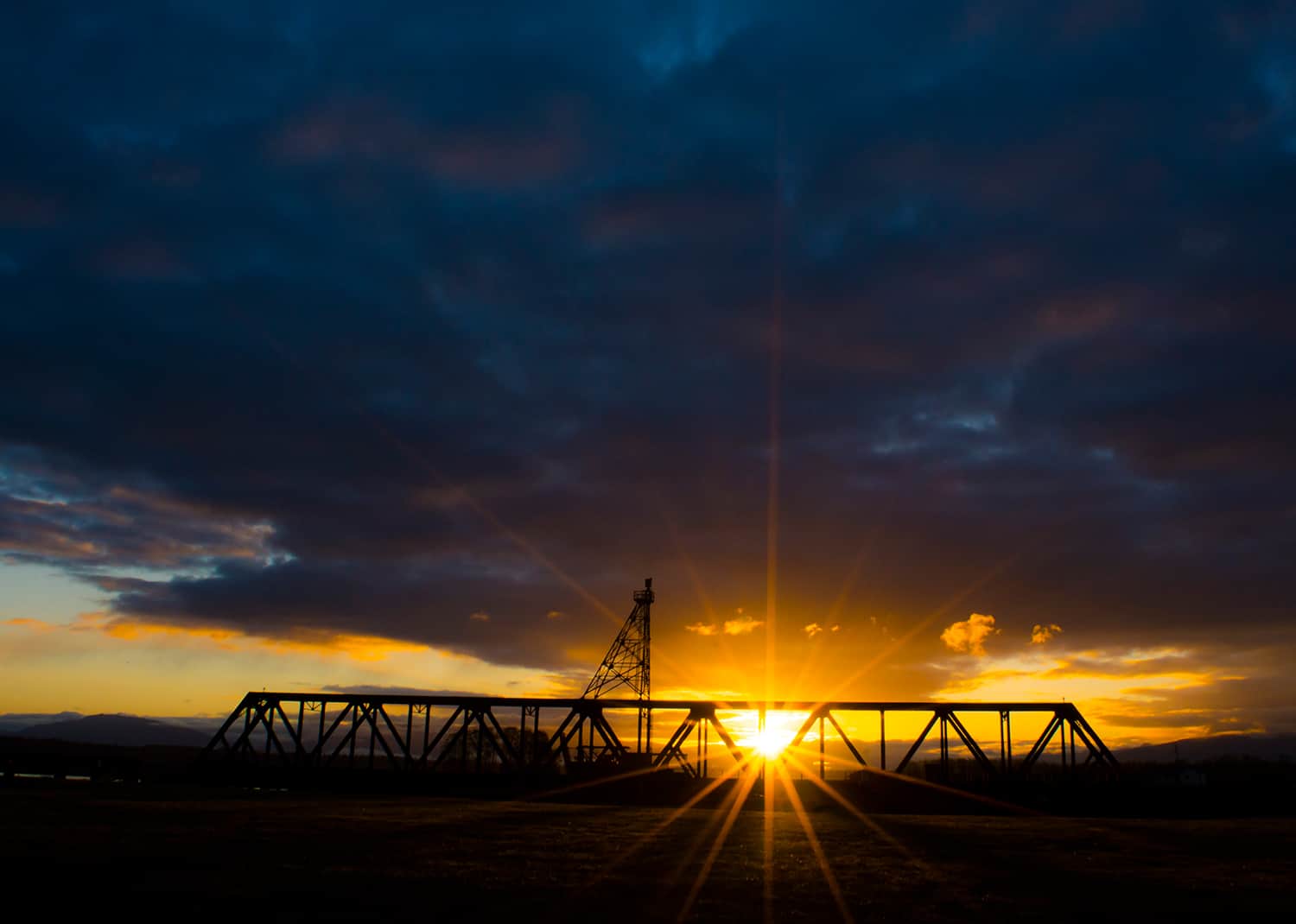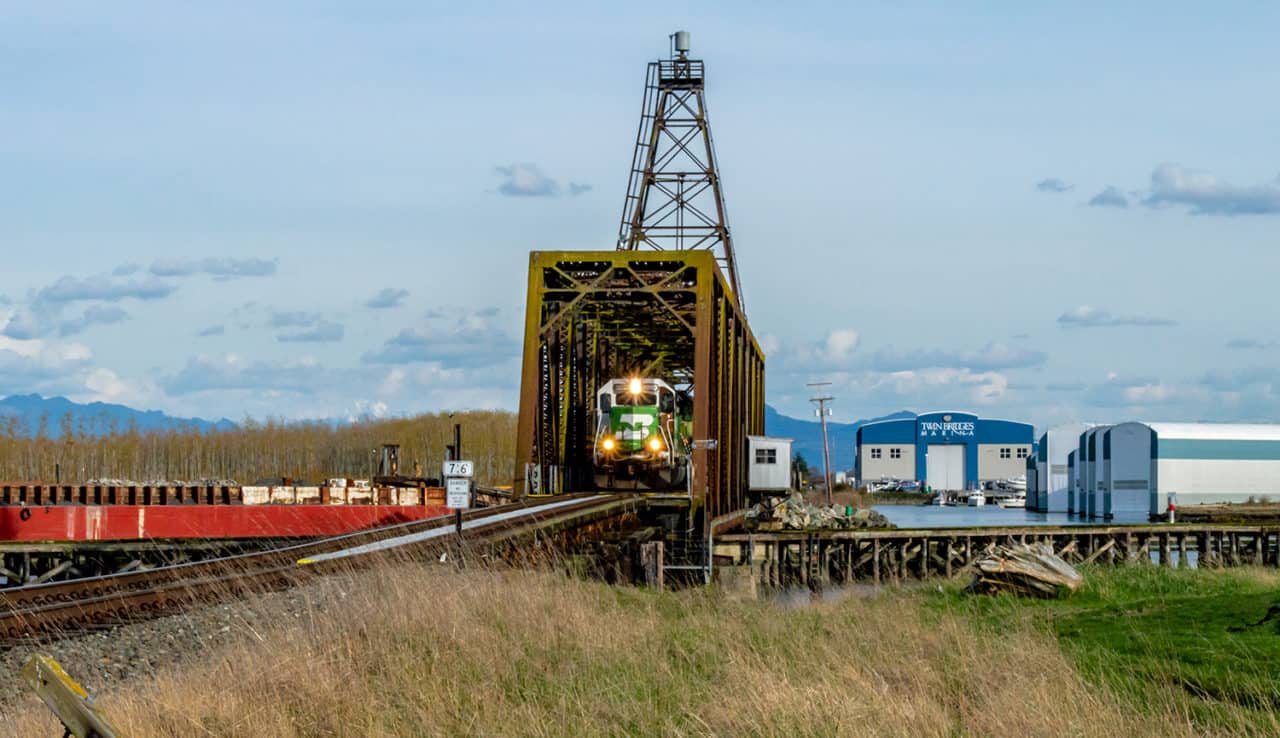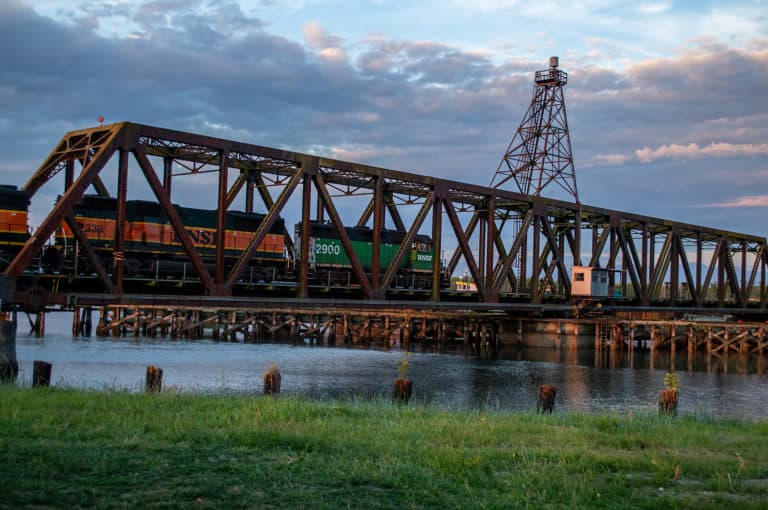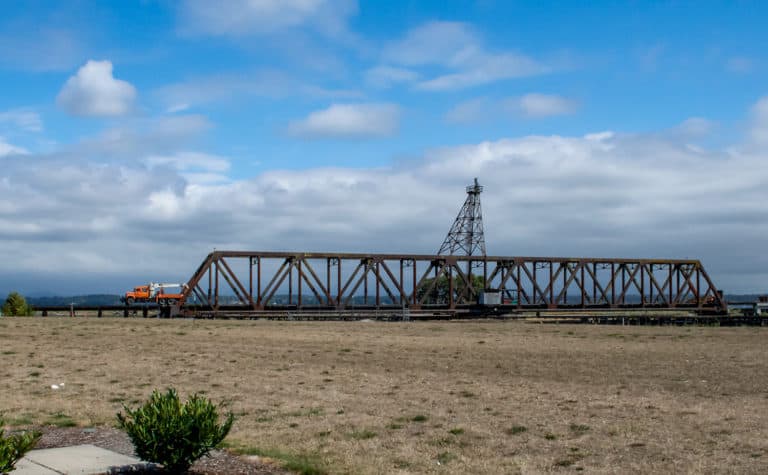Welcome to Anacortes! Once thought to be the western end terminus for the Great Northern due to its deep harbors and central access to the Pacific Coast, Puget Sound, and Canada. The rail line no longer runs in the City of Anacortes and its terminus is now across the bay at March Point, home to several oil refineries. The spur line, known as the Anacortes spur, begins just north of the Burlington yard and runs west along the north end of Highway 20. The line is owned and operated by BNSF Railway Company. To access the March Point refinery complex, the rail line crosses over two bridges, both part of the Swinomish Indian Reservation. The first crossing is over the Swinomish Channel, one of 3 northerly access points to the Puget Sound, followed by a smaller crossing over the southwest end of the Padilla Bay National Estuarine Research Reserve. The map below shows the location of both bridges.
The Swinomish Channel Bridge is a 368-foot-long steel Warren through-truss swing bridge (BNSF Bridge 7.6). Just down the line, a half-mile west of the channel crossing over Padilla Bay, is a smaller 121-foot-long open deck pile trestle bridge (BNSF Bridge 7.1). In 2017 and 2018, I captured some great images of the upgrades to the swing bridge and replacement of the trestle bridge. In this series of articles, I will highlight the work completed on both bridges and then delve into the history of the swing bridge and the years of controversary surrounding it.
SWINOMISH CHANNEL SWING BRIDGE
First up is the Swinomish Channel swing bridge. Pictured below is one of my first shots of the Swinomish Channel Swing Bridge (BNSF Bridge 7.6). Since then, I have taken hundreds of pictures of this bridge, in part, because I live on an island nearby and pass this bridge anytime I leave the island and because my work scheduled coincided with the local Annie for a couple of years. Needless to say, I have gotten to know the bridge tenders well – and over the years they have helped me greatly in my research by entertaining my curiosity and endless questioning on the structure and operation of this bridge.
WORK COMPLETED
Work began on the swing bridge in 2017. The work was completed by BNSF Railway and contractor Advanced American Construction Inc (AAC), a full-service marine construction company based out of Portland, OR. BNSF has contracted with AAC on several bridge and marine projects throughout the Pacific Northwest, many of which can be viewed from their website. Advanced American was contracted to replace the fender/whaler system, remove and replace the wood piers with steel piers and install a new walkway system for inspections and navigation lighting. The steel tower and insulator on top were also removed.
BEFORE
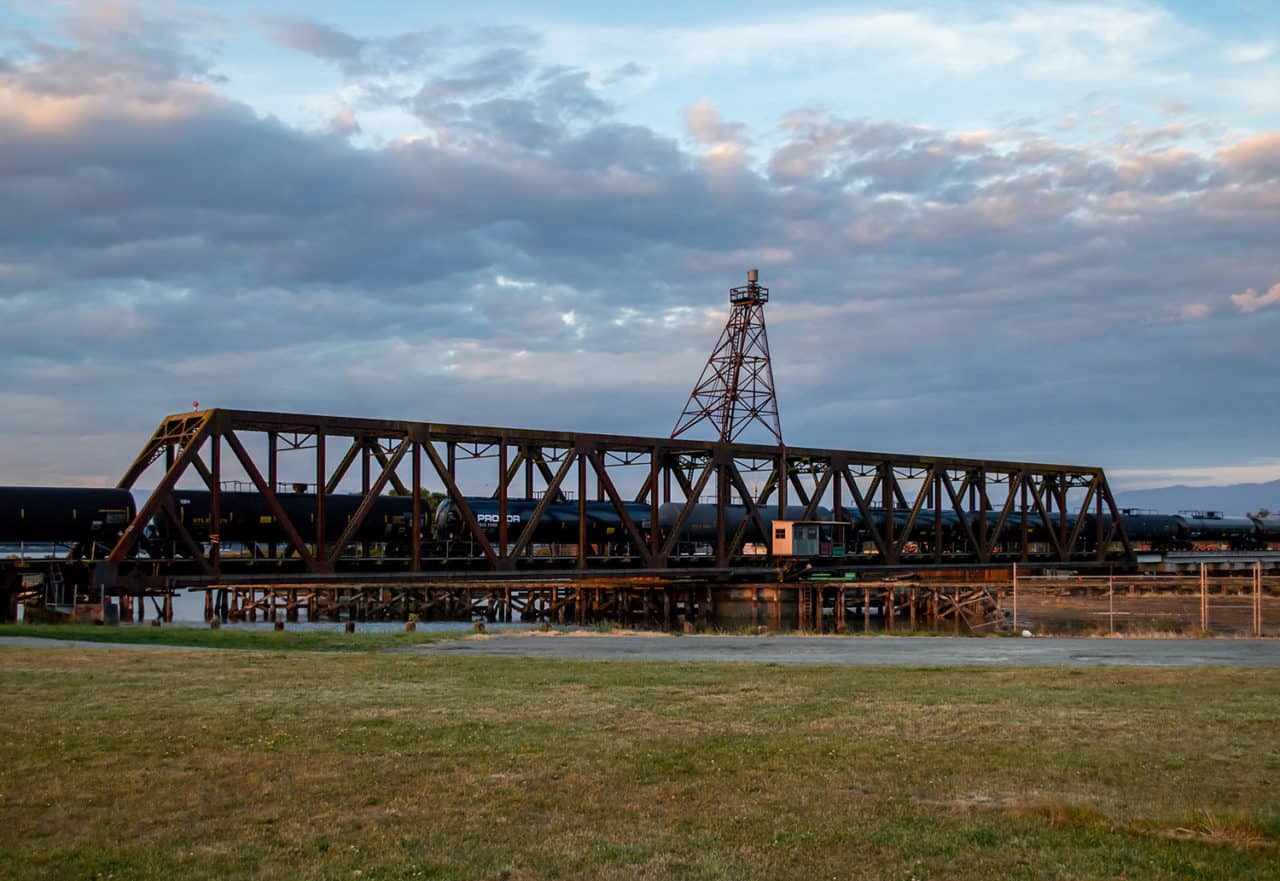
AFTER
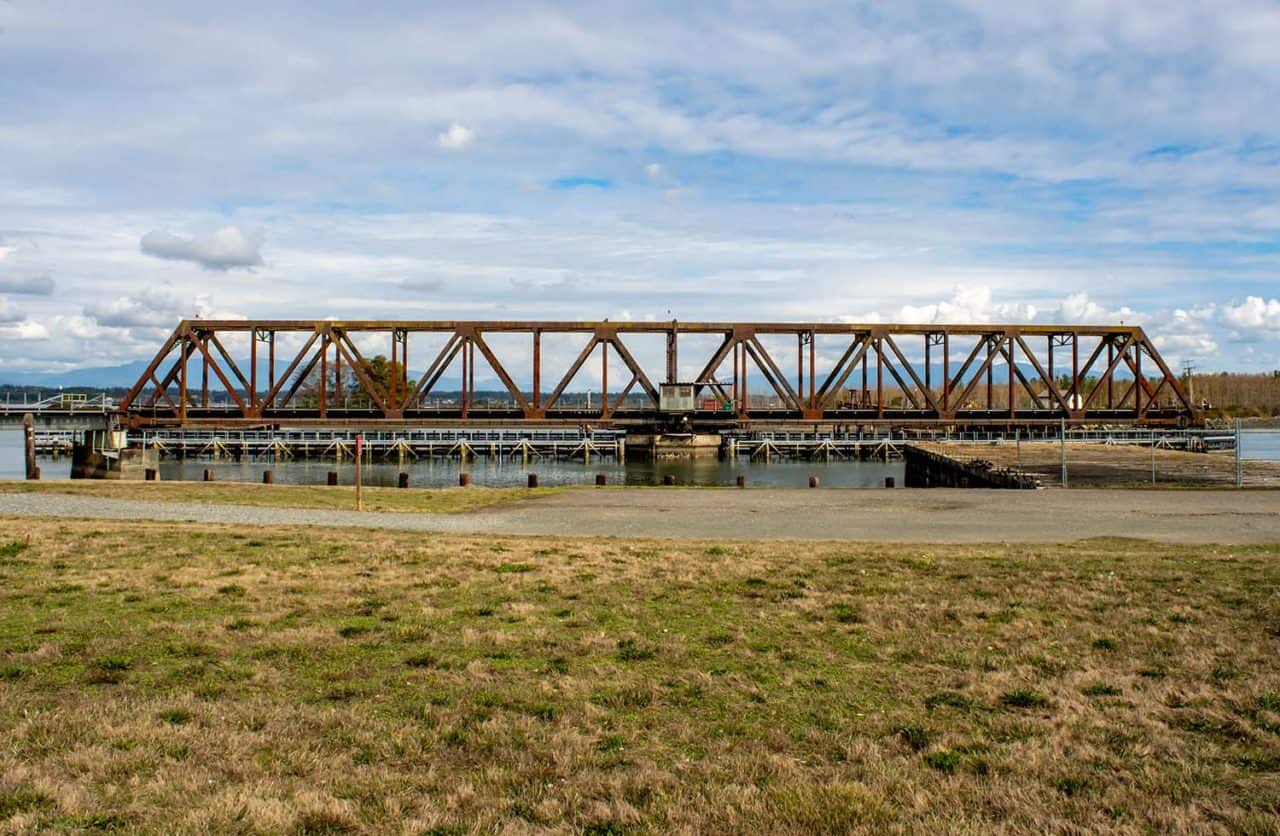
TIMBER PILE REMOVAL
Advanced American Construction used a derrick barge crane to remove the timber pilings around the fender system and at the west end approach to the bridge pier.
Timbers are removed by chainsaw and/or pulled with the derrick barge crane. The timber is attached by chain to the crane and then pulled from the sea floor and placed on the deck of the barge for disposal.
FENDER/WHALER SYSTEM
The fender system protects the bridge from water traffic. The old timber fender/ whaler system was removed and a new fender/whaler system was constructed on-site and secured around the center pier by crane.
Installation of New Walkway System
On the east end approach, which was replaced in 2003, a new walkway system was installed. This included a new handrail and metal walkway on the south side of the approach. Handrails were not necessary until the early 2000’s because the bridge tender use to cross the bridge in a motorized handcar. I am currently on a search for pictures of the handcar which I hope to show in future posts.
BEFORE
AFTER
REMOVAL OF THE TOWER AND INSULATOR
The tower and insulator on top of the bridge were removed in late 2017. I wasn’t present the day it was removed but if I had been, I would have probably chained myself to the bridge. I loved the look of the tower and insulator and I especially liked photographing the eagles that would gather on top and keep a watchful eye out.
The tower was part of the original bridge barged up from Seattle in 1953. The insulator was hand-built and, prior to the power running underground, the bridge was powered overhead by the insulator and electrical line. The tower was removed because it is no longer in use. Unknown to bridge engineers at the time though, the tower was being used, it was a hangout for eagles and they were serving a purpose. They didn’t just bring character to this bridge, they kept other birds (and their excrement) off the bridge. Now the flat-topped bridge is a haven for all and its new inhabitants have created a problem below. Look closely at the photos in the gallery and you might catch one of these beautiful majestic birds hanging out watching the train below.
Additional Resources
For more information on bridge types and structures check out the Historic Bridge Foundation which has a great explanation of bridge types. Historic Bridges also has some great information on historic bridges and several PDF’s on bridge basics. You can also watch an interesting video on bridges with some historic footage from Bill Nye.
Up Next.....
In part 2 of the Swinomish Channel Bridges series, I will show the work done on the replacement of the west end approach to the swing bridge. I spent a beautiful December day watching a BNSF Maintenance of Way crew replace this approach.

